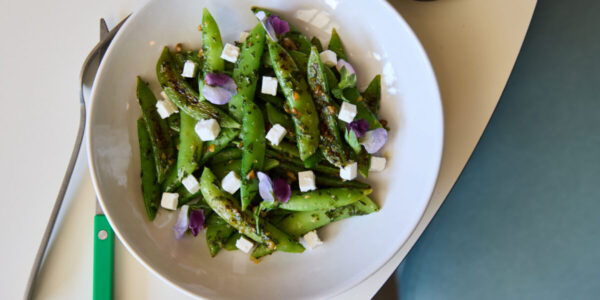Spun-Sugar Cobwebs
Spun-sugar recipes typically involve flinging hot liquid sugar across a setup of dowels and newspaper. It’s messy and, frankly, a little bit frightening. Here’s a much easier method that requires nothing more than a few forks and a small upturned bowl, and you can do it on your kitchen counter. The results–golden, airy sugar webs–make excellent Halloween cupcake toppers. (This recipe makes extra, so you can choose the prettiest ones.) For a bigger cobweb to top a cake, just use a large bowl. Make sure you do this on a dry day, though; humidity will make the webs collapse.
This recipe, and others like it, can be found in the article “44 Scary-Good Halloween Treats.”
How to Make It
Set out a couple of baking sheets on a work surface so they cover a couple of square feet (or cover the surface with any kind of paper). Using a few drops of vegetable oil and your fingers or a paper towel, lightly oil outside of a small (5- to 6-in. diameter) rimless metal, glazed ceramic, or glass bowl. Turn it over and set in center of prepared space. Gather 5 or 6 forks and a glass of water and set them together near the work surface.
Put water in a small (1-qt.) stainless-steel saucepan and evenly sprinkle in sugar (avoid dark enamel; you won't be able to see when the sugar changes color). Cook over medium-high heat, swirling occasionally so sugar cooks evenly, until sugar is dissolved and syrup is pale golden and as thick as honey, 8-15 minutes. Do not stir; stirring will make the sugar seize up into crystals. Meanwhile, prepare a large bowl of ice and cold water.
When syrup is golden and thick, remove pan from heat and set bottom in ice water 5 seconds to stop the cooking. Set on baking-sheet-lined work surface or a trivet near work area and let cool until syrup forms thin threads (rather than droplets); test by dipping a fork in and lifting.
When syrup is ready, dip fork into it and fling sugar threads quickly in a circular pattern across back of bowl, moving fork up and down and all around to form gossamer threads. (It helps to hold the saucepan in one hand and the fork in the other.) Repeat once or twice, then let sugar cool a few seconds. Quickly ease threads off bowl, starting from the bottom, with your hands (they will be barely warm) and shape into a loose sphere 3 to 4 in. wide. Put sticky fork in glass of water to dissolve sugar. Using a new fork each time (or until it's too gummy to use), repeat sugar-flinging to form 12 to 15 airy sugar cobwebs. You'll probably have to do a few before you get the hang of it, but once you do, it's magic. Also, if the caramel gets too thick, reheat over low heat until thin enough to use.
Make ahead: Up to 1 day in dry weather on the counter, uncovered. Up to 2 days, airtight at room temperature. Up to 2 weeks, airtight with a small container of desiccant--available at craft stores--inside container to absorb moisture. (Don't let it touch the sugar.)
Cleanup tip: Soak pan and forks and anything else that's sticky in hot water until sugar dissolves.
Ingredients
Directions
Set out a couple of baking sheets on a work surface so they cover a couple of square feet (or cover the surface with any kind of paper). Using a few drops of vegetable oil and your fingers or a paper towel, lightly oil outside of a small (5- to 6-in. diameter) rimless metal, glazed ceramic, or glass bowl. Turn it over and set in center of prepared space. Gather 5 or 6 forks and a glass of water and set them together near the work surface.
Put water in a small (1-qt.) stainless-steel saucepan and evenly sprinkle in sugar (avoid dark enamel; you won't be able to see when the sugar changes color). Cook over medium-high heat, swirling occasionally so sugar cooks evenly, until sugar is dissolved and syrup is pale golden and as thick as honey, 8-15 minutes. Do not stir; stirring will make the sugar seize up into crystals. Meanwhile, prepare a large bowl of ice and cold water.
When syrup is golden and thick, remove pan from heat and set bottom in ice water 5 seconds to stop the cooking. Set on baking-sheet-lined work surface or a trivet near work area and let cool until syrup forms thin threads (rather than droplets); test by dipping a fork in and lifting.
When syrup is ready, dip fork into it and fling sugar threads quickly in a circular pattern across back of bowl, moving fork up and down and all around to form gossamer threads. (It helps to hold the saucepan in one hand and the fork in the other.) Repeat once or twice, then let sugar cool a few seconds. Quickly ease threads off bowl, starting from the bottom, with your hands (they will be barely warm) and shape into a loose sphere 3 to 4 in. wide. Put sticky fork in glass of water to dissolve sugar. Using a new fork each time (or until it's too gummy to use), repeat sugar-flinging to form 12 to 15 airy sugar cobwebs. You'll probably have to do a few before you get the hang of it, but once you do, it's magic. Also, if the caramel gets too thick, reheat over low heat until thin enough to use.
Make ahead: Up to 1 day in dry weather on the counter, uncovered. Up to 2 days, airtight at room temperature. Up to 2 weeks, airtight with a small container of desiccant--available at craft stores--inside container to absorb moisture. (Don't let it touch the sugar.)
Cleanup tip: Soak pan and forks and anything else that's sticky in hot water until sugar dissolves.

